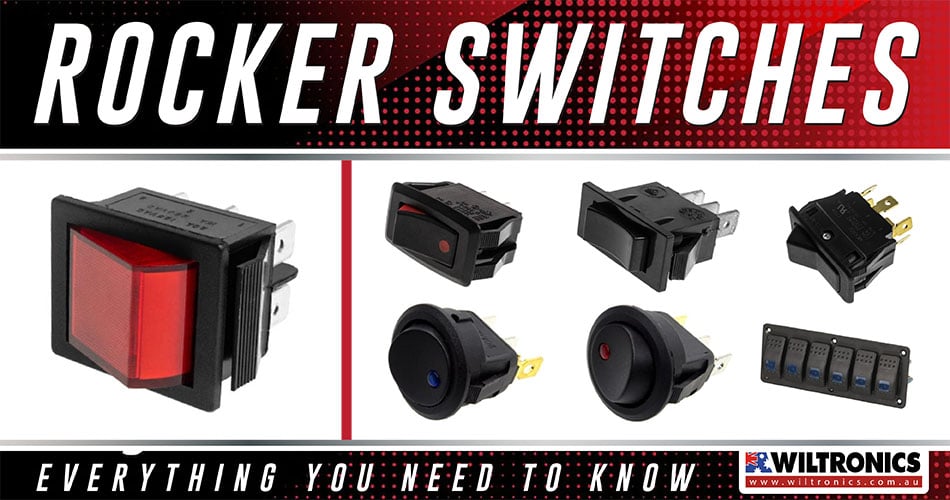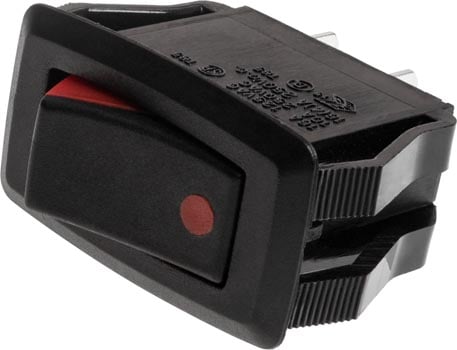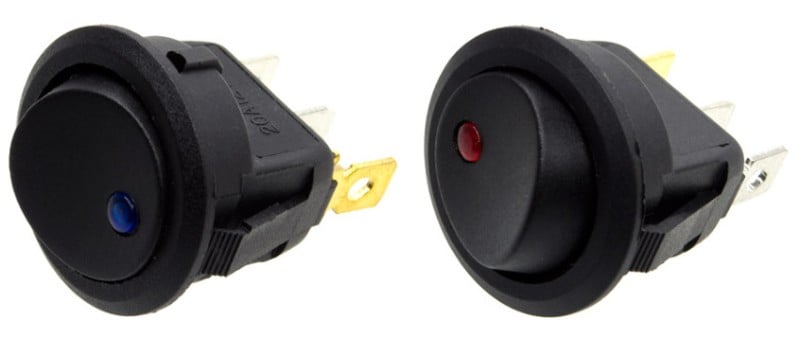Here’s Everything You Need to Know About Rocker Switches
November 4, 2022

Your light switches at home are a great example of rocker switches.
A rocker switch does exactly what the name says. It rocks back and forth, where one end is raised, and the other is depressed—like how a seesaw works.
It stays put in a tilt position until pushed with external physical force. The working principle is very much easy to understand.
But knowing more about their toggling characteristics will help you use them better. Use this guide to get started!
Rocker Switches
In 1884, electric switches were in a phase of tremendous growth and development. From the design to the mechanisms and applications, the demand for uses has increased.
Today, rocker switches are among the most familiar switch types you will encounter. Generally, they are panel mount switches designed for switching an electrical device.
Start or stop; ON or OFF. That is how they control the circuit’s current flow with each push on either side.
They switch part of the mechanism by rocking between two or more positions when pressed. As one end raises, the other lowers.
Rocker switches are very easy to operate and require little pressure to activate. They are commonly used in homes for light switches, and chances are you have a few in your house.
They can be contrasted with toggle or strip switches. With toggle switches, changing the switch involves moving a small lever up and down.
But rockers are not designed to move around in their housing this way. Instead, they tilt back and forth around a central pivot point.
The term “rocker switch” comes from the rocking motion that the switch makes. Other terms include a seesaw switch.
The structure of rocker switches
Sealed rocker switches consist of the following:
- Operation button. This button is manually pressed to switch between ON and OFF.
- Sealing rubber. A component used to seal the switch. It prevents moisture and foreign objects from entering the internal case.
- Semi-elliptical spring. It has a contact attached to the end. When the operation button is ON, it moves the contact to a fixed one. Then, it exerts high contact force for a stable connection between the two. But when it is OFF, the release contact force is increased, preventing contact welding.
- Internal case and lid. The components that make up the switch mechanism. Terminals, contacts and semi-elliptical springs are stored in the case and the lid as a seal.
- Cover. A resin component that covers the sealed internal case. It is also used to secure the sealing rubber into place. Moreover, it allows the switch to be easily mounted into a square hole in a panel.
- Contacts and terminals. The fixed contact is made by attaching a contact to the end of one of the terminals.
What Are Rocker Switches Used For?
Rocker switch uses covers a vast range of applications and devices. Most on-off power and light switches are found around homes or offices, including vehicles.
You can see them on wall sockets, power outlets, surge protectors and extensions. You will also find them on standalone appliances and integrated electrical devices.
Common everyday applications include:
- Fuse circuits
- Household appliances
- HVAC systems
- Hydraulic and pneumatic systems
- Medical equipment and machinery
- Power supplies and control panels
- Vehicle electronics and dashboards
Some rocker switches may feature illuminated areas with embedded LED lighting. Often with the colour red or orange to show active power flow.
But in general, the sides are usually marked with a “1” for ON and a “0” for OFF.
The Working Principles
It is very easy to operate and use a rocker switch. It only requires pressure on either side of the switch to ON > OFF or OFF > ON a device.
However, design upgrades have also led to some complex structures. For one, they can be prone to temporary sticking between the general toggle style.
To keep the function smoother, the switches are designed with spring-loading integration. Thus, they will return to the neutral position even without being pressed.
This is often the case with switches for things like powered windows or seat controls in cars.
Common Types of Rocker Switches in Circuit Design
There are four common types of rocker switches positions, and these are:
- Single Pole, Single Throw (SPST)
- Single Pole, Double Throw (SPDT)
- Double Pole, Single Throw (DPST)
- Double Pole, Double Throw (DPDT)
Single Pole, Single Throw (SPST)
An SPST has a single input and can connect only to one output. Meaning it only has one input terminal and one output terminal.
It serves in circuits as an ON-OFF switch. When the switch is closed, the circuit is on. Vice versa. SPST switches are, thus, very simple in nature.
Example:
A desk fan has a single rocker switch that turns it OFF or ON. The rocker controls one circuit and has one ON position, making it an SPST switch.
Single Pole, Double Throw (SPDT)
An SPDT has a single input and can connect to and switch between two outputs. Unlike SPST, it has one input terminal and two output terminals.
It can be used for various functions in a circuit, such as an ON-OFF switch, depending on how the circuit is wired. It also can connect the circuit to any two various paths that a circuit may need to function in.
Example:
A similar desk fan has a single rocker switch. But the rocker can select between off, low-power, and high-power modes.
The rocker can control one circuit with two ON positions, making it an SPDT switch.
Double Pole, Single Throw (DPST)
A DPST has two inputs and two outputs, with each input having a single corresponding output. The terminals can either be in the ON position (closed) or the OFF position (open).
What makes it different from the previous two is it accepts double inputs. And with that, it can drive two different outputs in a circuit.
What it drives depends on the circuit designs and what it is intended to do. All in all, a DPST has various applications in circuits.
Example:
A hairdryer has a single rocker switch that turns it either OFF or ON. When it is ON, the power is delivered to both the blower motor circuit and the heating element circuit.
The rocker controls two circuits and has one ON position, making it a DPST switch.
Double Pole, Double Throw (DPDT)
A DPDT consists of six terminals, two of which are independent input terminals. Each of the poles can complete two different circuits.
In other words, each input terminal connects with two output terminals. Plus, all four of the output terminals are separate.
DPDT switches are the most advanced type of rocker switch.
Example:
A similar hair dryer has a single rocker switch. But the rocker can select between off, low-power, and high-power modes.
The rocker can control two circuits and has two ON positions, making it an SPDT switch
Every type of rocker switch has two main components that control the circuit:
- Switch Pole
- Switch Throw
Switch Pole
This refers to the number of separate circuits the switch can complete (close) when it is in the ON position. If a rocket delivers or interrupts power to one circuit, it is a single-pole.
That is true even if it has multiple ON positions (multi-throw). But if it can control two separate circuits, singly or together, it is a double-pole switch.
Note: Do not confuse ‘pole’ with ‘terminal’. The DPST switch, for example, has four terminals, but it is a DP, not a 4P switch.
Switch Throw
The number of throws shows how many output connections each switch pole can connect its input to. If it is a simple ON-OFF rocker, it is a single-throw switch, even if it closes more than one circuit at once (multi-pole).
But if it has two ON positions – for instance, OFF, low power, and high power – it is a double-throw switch.
Get Your Rocker Switches Here!

SPST Rocker Switch Red Marked
Product code: SW2600
Single Pole, Single Throw Switch, ON-OFF 240VAC 10Amp
Fits Cut-Out 27.5mm x 13.8mm

SPDT Black Rocker Switch ON-OFF-ON
Product code: SW2604C
S40 Swann Single Pole, Double Throw Switch, ON-ON 240VAC 10Amp
Fits Cut-Out 27.5mm x 12.2mm

10A Rocker Switch DPDT ON-OFF-ON Black
Product code: SW2618
6 Pin Rocker Switch, DPDT, Centre Off, ON-OFF-ON 240VAC 10A AC.
Fits Cut-Out 37mm x 21mm.

DPDT Illuminated Rocker Switch ON-OFF
Product code: SW2614
S50 Double Pole Double Throw, ON-ON 240VAC Illuminated 15Amp.
Fits Cut-Out 27.2mm x 21mm.

15A DPDT Rocker Switch On-On Black
Product code: SW2602S
S2 15A DPDT (Double Pole Double Throw) ON-ON Rocker Switch.
Fits Cut-Out 34mm x 21mm.

DPDT Black Rocker Switch MOM-OFF-MOM
Product code: SW2665
Momentary on each way, (ON)-OFF-(ON), returns to the centre.
Fits Cut-Out 29mm x 22mm.

Round Rocker Switches
Product code: SW323x
Includes built-in indicator lights that illuminate when you activate the switch. They fit into a 20.2mm diameter mounting hole – rated up to 20A @ 12VDC.
They also feature three terminals: two normal terminals and a ground tab for the LED lamp inside.
Rocker Switch Panel 6 Way Illuminated Blue
No longer available
Product code: JSZ1925
Pre-wired with just four connections, it is simple to wire and install. All you need to do then is connect your various peripheral devices.
Switches are classified at 20A for a 12V system (10A for 24V) up to a maximum of 45A per panel. LED illumination is powered separately. You can also run it through a dimmer or switch.
Rocker Switches: The Bottom Line
In a nutshell, rocker switches are used to turn the main power supplies on electric devices ON and OFF. And the next time you shop, you can be confident of the difference between rocker and toggle switches. Also, to understand the different types of rocker switches available.
© Electrotech Brands Pty Ltd 2022


Write a Comment
You must be logged in to post a comment.